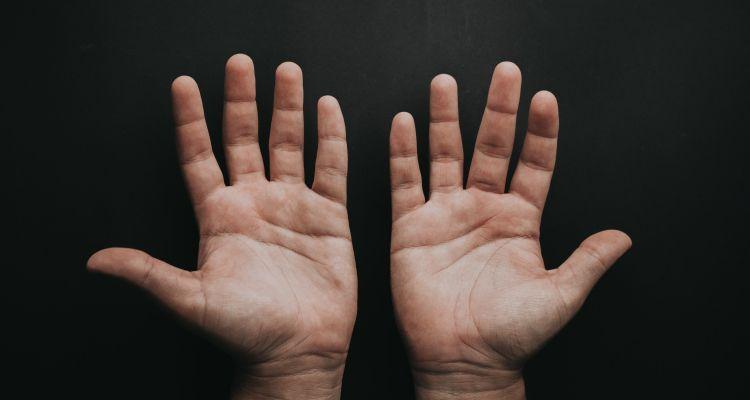
Skin rash - causes and treatment
Updated on 02. November 2023
A skin rash is a common dermatological disease with very diverse causes. It is characterised by red patches or blisters on the skin with severe itching. Sudden skin rash can occur all over the body in adults and children and can even cause burning and pain.
Skin rash Brief overview:
- Causes: Multiple causes
- Symptoms: Redness, itching, burning, scaling
- Prevention: Avoidance of irritants
- Treatment: Cream, medicines
What are the symptoms of a skin rash?
A skin rash is a visible change in the skin. This can be manifested by different symptoms, depending on the cause and type of rash. Common symptoms that can accompany skin rashes are:
- Redness: the affected area of skin usually has red patches when there is a rash.
- Itching: A common symptom of skin rashes is [itching\]\(/pruritus/).
- Pain or burning: In some cases, rashes may be accompanied by pain or a burning sensation.
- Raised spots or blisters: Rashes may manifest as raised patches, blisters or pustules on the skin. The size, shape and texture may vary depending on the type of rash.
- Scaling: Some rashes may cause the skin to flake or peel.
- Swelling: In some cases, the affected area may swell, resulting in increased volume or thickening of the skin.
- Sensitivity: The skin may be sensitive to touch or pressure.
What are the different forms of skin rash?
Skin rash is a general term describing any pathological change of the skin. Various forms fall under this umbrella term, such as:
- Eczema: [Eczema]() is a specific type of skin rash manifested by inflammatory changes in the skin. It is a chronic condition manifested by red, itchy, scaly and sometimes weeping skin lesions.
- Exanthema: This is a characteristic feature of a systemic disease or a reaction to medication. The rash usually appears suddenly and over a large area of the skin. It can take various forms, including spots, pappules, pustules or blisters.
- Urticaria: Acute or chronic skin condition known as hives. It is characterised by a sudden rash of itchy, raised, red patches. The affected skin areas often resemble the effects of contact with stinging nettles, hence the name "hives".
Does itching always occur with a skin rash?
Itching is a typical symptom that is very common with skin rashes. This can range from mild scratching to intense, excruciating itching. Scratching is controlled by the brain as a reaction to [itching\]\(/pruritus/). In the first moment, this can lead to a relief of the discomfort. At the same time, however, scratching causes additional irritation of the skin and can lead to inflammation. Therefore, scratching should be avoided.
What are the causes of skin rash?
The causes of a skin rash can be very diverse. Besides contact of the skin with triggering substances, diseases can also trigger the changes in the skin. The shape and location of the rash often give clues to the cause.
What can cause a skin rash?
There are many different causes of skin rashes. Some of the most common triggers are allergic reactions, infections and skin diseases.
- Allergic reactions: Allergies to certain foods, medicines, pet hair or chemicals can cause allergic skin rashes. Examples include urticaria (hives) after an insect bite or allergic contact dermatitis from nickel jewellery.
- Infections: Viral infections such as chicken pox, measles, rubella, scarlet fever or herpes often cause skin rashes. Likewise, bacterial infections such as Lyme disease or syphilis can cause a rash.
- Skin infections: Infections of the skin with fungi, bacteria, viruses or parasites cause various skin rashes. A common pathogen is the yeast Candida, which can cause thrush. If bacteria such as streptococci enter the upper layer of the house, they can cause inflammation with a skin rash. Parasites such as mites in scabies or crabs in hairy areas also cause a reaction of the skin with redness and itching.
- Skin diseases: Various skin diseases such as neurodermatitis, psoriasis, rosacea or acne can cause skin rashes. These start suddenly with an exanthema and spread over the surface of the skin.
- Medications: A photoallergic reaction can occur when taking certain medications. This occurs when there is simultaneous contact with sunlight or UV radiation while taking the medication. Potential causative agents of photoallergic rashes include: Antibiotics, anticoagulants, cortisone medications and diuretics.
- Autoimmune diseases: Certain autoimmune diseases such as lupus erythematosus or dermatomyositis may be associated with rashes.
- Hereditary predisposition: In some cases, skin rashes are triggered by hereditary conditions such as Reiter's disease, Mediterranean fever or the metabolic disease porphyria.
- Sunlight: Sun exposure can cause skin rashes, such as sun allergy (polymorphous light dermatosis).
- Stress: During stressful phases of life or psychological strain, people can develop itchy skin rashes, stress pimples, eczema and even neurodermatitis.
What are the causes of a skin rash in children?
In children, additional factors may cause a rash. These include:
- Nappy dermatitis: This rash occurs in the nappy area and is recognisable by bright red areas of skin. It is caused by contact of the baby's sensitive skin with urine and stool. Another cause of nappy eczema can be an infection with the yeast Candida. In this case, additional pustules form on the reddened skin.
- Seborrhoeic dermatitis: This disease usually occurs in children as so-called "milk crust". The rash usually manifests itself in babies and small children as yellowish scales on the scalp.
- Atopic dermatitis: This is a chronic inflammatory skin disease that occurs mainly in children. It is caused by a genetic disorder of the immune system in which the skin barrier is impaired.
- Viral infections: Viral infections that cause a rash are more common in children.
If skin rashes occur in babies and children, a visit to the doctor is recommended. The doctor will find out the cause and initiate treatment.
Can an infection with Corona cause a skin rash?
In some cases, an infection with the SARS-CoV-2 coronavirus causes a reaction of the skin. Blisters, pustules or redness then appear on various parts of the body. A skin rash can also occur directly after infection with corona. However, a reaction of the skin is not a leading symptom and therefore does not indicate an infection.
How is rash treated?
The treatment of rash depends on the underlying cause and the type of rash. Therefore, the identification of the trigger is of particular importance. If the rash is caused by a known allergy, it can usually be quickly remedied by avoiding the trigger. If there are other causes, they should be treated specifically. Additional treatment of the rash is often useful to alleviate the symptoms.
What medicines help with skin rash?
The type of drug treatment depends on the cause and severity of the disease. In addition to treating the causes, the focus of treatment is on improving the symptoms.
- Fighting pathogens: Infections with bacteria, viruses or fungi are fought with the appropriate drugs such as antibiotics, antivirals or antimycotics. If mites are causing the rash, treatment with approved insecticides for scabies should be started immediately.
- Local treatments: Depending on the type of rash, treatments with corticosteroid creams or ointments may be used to relieve inflammation and itching. For allergic reactions, antihistamines can reduce inflammation and therefore itching.
- Systemic medications: In some cases, a severe or long-lasting rash may require oral use of anti-inflammatory, anti-allergic medications. These include tablets with corticosteroid agents and antihistamines that simultaneously suppress the immune system.
The medications can cause undesirable side effects. Therefore, these should only be taken after consulting the attending physician.
What measures support the healing of a skin rash?
In addition to the specific treatment of the causes of the rash, patients can support the healing process through their behaviour. This includes measures such as:
- Avoidance of irritants: To support healing and avoid further irritation, possible irritants such as aggressive detergents and fragrances should be avoided.
- Comfortable clothing: Clothing made of breathable, natural fabrics such as cotton allows air to reach the skin and thus supports healing. At the same time, clothing should be loose-fitting and not chafe or rub against the skin during movement.
- Moisturising and soothing: For dry rashes, regular application of moisturising creams or lotions is useful. This will soothe the skin and prevent dehydration.
- Relaxation techniques: For rashes caused by stress, relaxation techniques such as yoga or autogenic training can often help.
What helps against itching?
It is difficult to suppress the urge to scratch. Nevertheless, sufferers should refrain from doing so if possible to avoid infections. Alternatively, the affected area can be gently touched or patted.
Targeted treatment of the itching is beneficial. Witch hazel, also known as witch hazel, has proven particularly effective for this purpose. This medicinal plant is traditionally used to relieve itching and skin irritations. Witch hazel contains astringent substances. These contract the skin and constrict the blood vessels. This reduces the itching. In addition, tannins and flavonoids in witch hazel have an anti-inflammatory effect and soothe the skin. This can additionally alleviate the itching and reduce the discomfort. Witch hazel is often used in the form of witch hazel water, witch hazel extract or witch hazel creams. Before using witch hazel, make sure that no allergic reactions occur.
What home remedies help with skin rash?
When treating a rash, some home remedies can also help to relieve discomfort. Important home remedies to help with treatment are:
- Cooling compresses: Applying cool compresses can relieve itching and inflammation. The compresses should be cool, but not ice cold, so as not to further irritate the skin.
- Oatmeal: An oatmeal bath can help relieve itching and soothe the skin. For this purpose, ground oat flakes are put into a water-permeable bag. This remains in the water during the bath. Alternatively, soaked oatmeal can be used to gently dab the affected skin.
- Natural oils: Natural oils such as coconut oil, almond oil or evening primrose oil can be applied to the skin to moisturise and reduce inflammation. The effect is optimal when the oils are applied to moist skin.
- Aloe vera: Aloe vera gel has soothing and anti-inflammatory properties. Apply fresh aloe vera gel or a natural aloe vera cream to the affected skin area several times a day.
- Chamomile tea: Chamomile tea can have anti-inflammatory and soothing properties. Compresses are dipped in the tea and then felt.
Home remedies may not treat the underlying cause of the rash. If the rash persists, worsens or is accompanied by other symptoms, it is advisable to see a doctor for an accurate diagnosis and appropriate treatment recommendations.

Hameli's vision
Go to Vision
Vaginal Fungus - Symptoms, Causes & Treatment
Go to Vaginal mycosis
Dry skin - What helps against it?
Go to Dry skin
Witch hazel - varieties, cutting, effect, & products
Go to Witch Hazel
Recognise and treat coccygeal fistula
Go to Coccygeal fistula
Anal fistula - symptoms, causes & treatment
Go to Anal fistula
Labial tear - Symptoms, Causes & Treatment
Go to Labial tear
Intertrigo - Cause, symptoms and treatment of the skin wolf
Go to Intertrigo
Anal abscess: symptoms, recognition, causes & treatment
Go to Anal abscess
Chickenpox - symptoms, vaccination, infection and treatment | Hamelis
Go to Chickenpox
Seborrhoeic Eczema - Symptoms, Causes & Treatment
Go to Seborrhoeic eczema
Anal fissure - Symptoms. Causes & home remedies
Go to Anal fissure
Vaginal dryness - symptoms, causes & treatment
Go to Vaginal dryness
Hives - Cause, symptoms and treatment
Go to Hives
Hamelis experts
Go to Experts
Rose lichen - symptoms, causes and treatment
Go to Rose lichen
Scars - treatment and removal
Go to Scar
Ringworm: Symptoms, Causes & Treatment
Go to Ringworm
Scabies - symptoms, cause and treatment
Go to Scabies
Treat anal eczema sustainably
Go to Anal eczema
Eczema - symptoms, causes and treatment
Go to Eczema
Contact allergy - symptoms and treatment
Go to Contact allergy
Treat stubborn nail fungus
Go to Nail fungus
Crabs - Intimate area, symptoms & treatment
Go to Crabs
Pruritus - Causes, symptoms and treatment
Go to Pruritus
Rosacea on the face - symptoms, causes and treatment
Go to Rosacea
Perioral dermatitis - symptoms, treatment & home remedies
Go to Perioral dermatitis
Skin fungus - cause, symptoms and treatment
Go to Skin fungus
Perineal tear - origin, degrees & causes
Go to Perineal laceration
Anal prolapse: symptoms, causes, treatment
Go to Anal prolapse
Genital herpes - woman, man & symptoms
Go to Genital herpes
Atopic dermatitis in children, adults and pets
Go to Atopic dermatitis
Angioedema - symptoms, causes and therapy
Go to Angioedema
Nappy dermatitis - cause and treatment of sore baby bottom
Go to Diaper rash
Sunburn - symptoms, duration & what helps?
Go to Sunburn
